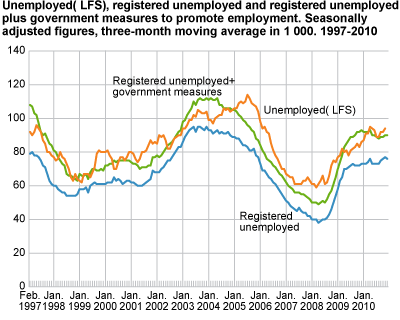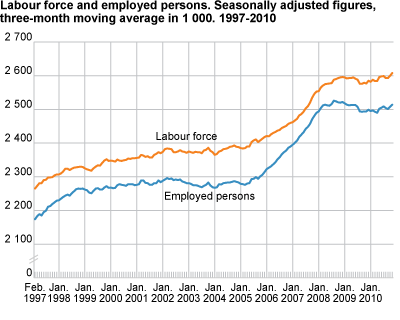Content
Published:
This is an archived release.
Increasing number of underemployed
From the 4th quarter of 2009 to the 4th quarter of 2010 the number of underemployed persons increased by 13 000 persons. In the 4th quarter of 2010 there were a total of 67 000 underemployed persons.
Seasonally-adjusted figures: stable labour marketBoth employment and unemployment remained stable from the 3rd quarter to the 4th quarter of 2010. The unemployment rate in November was 3.6 per cent. Adjustments for seasonal variations allow for the analysis of current developments in the labour market, and serve as an alternative to comparisons with the corresponding quarter in the previous year. Seasonally-adjusted figures are presented in a separate article . |
Underemployment is employees with part-time contractual working hours who have tried to find more work. Together, the groups of underemployed and unemployed wanted work corresponding to 98 000 full-time equivalents in the 4th quarter of 2010; up 15 000 from the year before.
Between the 4th quarter of 2009 and the 4th quarter of 2010 the number of unemployed increased by 10 000 persons. The increase was among people who have been unemployed for less than three months. The share of long-term unemployed was unchanged throughout the period. From a total of 85 000, 20 000 persons were long-term unemployed. Long-term unemployed are people who have been out of work for more than 26 weeks.
Decrease in labour force participation
In the 4th quarter of 2010 the labour force participation rate was down 0.4 percentage points, ending at 71.4 per cent. The decrease was among women. The labour force participation rate among women was 68.3 per cent in the 4th quarter of 2010, and 74.5 per cent among men.
|
The labour force is the sum of employed and unemployed between 15-74 years of age. From the 4th quarter of 2009 to the 4th quarter of 2010 the LFS shows that employment rose by about 20 000 persons and unemployment rose by 10 000 persons. This gives an increase in the labour force on the of 30 000 persons. The coherence between the conceptsUnemployed + Employed = Labour force Labour force + Outside the labour force = Population |
Even though the labour force participation among women decreased, the share of full-time employed women has increased with 1 percentage point over the last year. In the 4th quarter of 2010 the share of full-time employment among women was approximately 60 per cent. In the same period, 86 per cent of male employees were full-time employed.
Outside the labour force
The working-age population (15-74) increased by 61 000 persons, which signifies that the increase in the number outside the labour force was 31 000. Of the persons outside the labour force, 19 000 more persons were early retired/disabled or retired.
Increase in employment within human health and social work activities and other service activities
From the 4th quarter of 2009 to the 4th quarter of 2010, employment rose by 20 000 persons. Other service activities and human health and social work activities had an increase of 8 000 and 13 000 persons respectively.
In the 4th quarter of 2010 there were 186 000 persons in temporary contracts. This amounts to 8 per cent of the total employment. The use of temporary contracts is most frequent within accomodation and food service activities1 and human and health social work, with 12 and 14 per cent of the employees respectively.
| 1 | Text was corrected 2 February 2011 at 12.30 a.m. |
Tables:
- Table 1. Population aged 15-74 by labour force status(LFS) and sex. 1000
- Table 2. Population aged 15-74 by labour force status (LFS) and sex. Changes from the same period inthe previous year. 1000
- Table 3. Population aged 15-74 by labour force status(LFS) and sex. Per cent
- Table 4. Persons in the labour force and employed persons aged 15-74, by age and sex (LFS). 1000
- Table 5. Persons in the labour force and employed persons aged 15-74, by age and sex (LFS). In per cent of the population
- Table 6. Persons aged 15-74, employed persons by contractual/usual working hours per week1 and unemployedpersons by age and sex (LFS). 1000
- Table 7. Persons in the labour force aged 15-74 by age and sex (LFS). 1 000. 1000
- Table 8. Persons in the labour force aged 15-74 by age and sex (LFS). As per cent of all in each group'
- Table 9. Employed persons aged 15-74 by sex and contractual/usual working hours per week (LFS). 1 000
- Table 10. Population aged 15-74, by main activity, part-time employment and age (LFS). 1 000
- Table 11. Employed persons aged 15-74 by major industry division (LFS). 1 000
- Table 12. Average number of man-weeks worked1(37,5 hours), by industry division (LFS). 1 000
- Table 13. Employed persons aged 15-74 and average number of man-weeks worked1(a 37.5 hours)by sex and status. 1000. Actual working hours, by sex and status. Hours per week
- Table 14. Employed persons aged 15-74 and absence from work1 during the whole reference weekby reason for absence and sex (LFS). 1 000
- Table 15. Employed persons aged 15-74 and absence from work1 during the whole reference weekby reason for absence and sex (LFS). Per Cent
- Table 16. Employees aged 15-74 with temporary jobs, by major industry division (LFS). 1000
- Table 17. Employees aged 15-74 with temporary jobs, by major industry division (LFS).In per cent of all employees
- Table 18. Unemployed persons aged 15-74 by sex and age (LFS). 1000 and per cent
- Table 19. Unemployed persons aged 15-74 by duration of job search (LFS). 1 000 and per cent
- Table 20. Unemployed persons aged 15-74, by main activity (LFS). 1 000
- Table 21. Unemployed and underemployed persons aged 15-74, by sex and desired working hours per week.Number of man-weeks (of 37,5 hours) supplied'
- Table 23. Employed persons aged 15-74, by sex and region (LFS) 1 000
- Table 24. Employed persons aged 15-74, by sex and regions (LFS) as per cent of all inn each group
Contact
-
Arbeidsmarked og lønn
E-mail: arbeidsmarked@ssb.no
-
Erik Herstad Horgen
E-mail: erik.horgen@ssb.no
tel.: (+47) 93 08 68 62
-
Håvard Hungnes Lien
E-mail: havard.lien@ssb.no
tel.: (+47) 40 90 26 06


